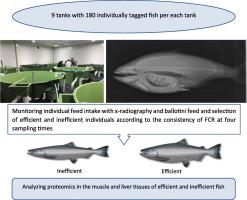Aquaculture ( IF 4.5 ) Pub Date : 2021-05-01 , DOI: 10.1016/j.aquaculture.2021.736855 Moha Esmaeili , Chris G. Carter , Richard Wilson , Seumas P. Walker , Matthew R. Miller , Andrew Bridle , Jane E. Symonds

|
Feed efficiency, the relative ability to convert feed nutrients into growth, is an important factor in the primary production of animals. Farming fish with improved feed efficiency is necessary to reduce production costs and achieve sustainability for the aquaculture industry. Proteomics provides an approach to discover biochemical mechanisms driving feed efficiency. To do this, we have evaluated the proteomic profile of liver and white muscle in efficient (EFF) and inefficient (INEFF) Chinook salmon (Oncorhynchus tshawytscha). Twenty-six fish, 14 EFF and 12 INEFF individuals, were assessed using liquid chromatography-tandem mass spectrometry (LC-MS/MS) and a data-independent acquisition method. In total, 2433 liver and 635 white muscle proteins were quantified across all samples. Bioinformatics showed enrichment of gene ontology (GO) terms related to lipid metabolism in liver of EFF fish (~30% of total GO terms). Protein metabolism (~30% of total GO terms) were the top enriched pathways in white muscle of EFF fish. In INEFF fish, protein processing in endoplasmic reticulum and proteolysis (~40% of total GO terms) were the highest enriched GO terms in the liver. This is the first study to compare feed efficient and inefficient individuals at the proteomic level in an aquatic species and the results provide a preliminary insight into the fundamental molecular landscape of feed efficiency in Chinook salmon.
中文翻译:

高效和低效率的奇努克鲑鱼(Oncorhynchus tshawytscha)中肝脏和白肌的蛋白质组学研究:脂肪酸代谢和蛋白质更新驱动饲料效率
饲料效率是将饲料养分转化为生长的相对能力,是动物初级生产的重要因素。为了降低生产成本并实现水产养殖业的可持续性,必须提高饲料效率来养殖鱼类。蛋白质组学提供了一种发现驱动饲料效率的生化机制的方法。为此,我们评估了奇努克鲑(Oncorhynchus tshawytscha)在高效(EFF)和低效(INEFF)奇努克鲑鱼(Oncorhynchus tshawytscha)。使用液相色谱-串联质谱法(LC-MS / MS)和数据独立获取方法评估了26条鱼,分别为14个EFF和12个INEFF。总共对所有样品中的2433肝蛋白和635白肌蛋白进行了定量。生物信息学显示与EFF鱼肝中脂质代谢有关的基因本体(GO)术语的丰富(约占总GO术语的30%)。蛋白质代谢(约占总GO含量的30%)是EFF鱼白肌肉中最富集的途径。在INEFF鱼中,内质网中的蛋白质加工和蛋白水解(约占总GO含量的40%)是肝脏中富集的最高GO含量。


























 京公网安备 11010802027423号
京公网安备 11010802027423号